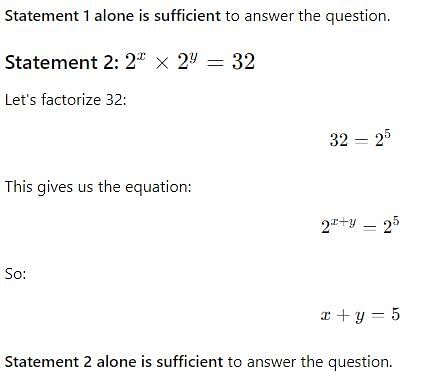Test: Exponents/Powers - GMAT MCQ
10 Questions MCQ Test - Test: Exponents/Powers
What is the units digit of 4^n?
(1) n = 2x + 1, where x is a positive integer.
(2) n = 2k – 1, where k is a positive integer.
(2) n = 2k – 1, where k is a positive integer.
If x is a positive integer and w is a negative integer, what is the value of xw?
(1) xw = 1/2
(2) w = -1
(2) w = -1
| 1 Crore+ students have signed up on EduRev. Have you? Download the App |
If x is a positive integer, is the remainder 0 when 3x + 1 is divided by 10?
(1) x = 4n + 2, where n is a positive integer.
(2) x > 4
(1) x = 4n + 2, where n is a positive integer.
(2) x > 4
What is the units' digit of 76k, where k is an integer ?
(1) k is a prime number
(2) k is greater than 2
For a positive integer x, what is the value of the hundreds digit of 30x ?
(1) x ≥ 3.
(2) x/3 is an integer.
If x and y are positive integers, is 100x + y divisible by 9 ?
(1) x = 5
(2) y = 98
If x and y are positive integers, what is the value of x + y ?
(1) 2x 3y = 72
(2) 2x 2y = 32
If x and y are both nonzero integers, is 25% of xy greater than x?
(1) x is positive
(2) y is even
If x and y are positive integers, what is the remainder when 5x is divided by y?
(1) x = 3
(2) y = 4
What is the value of integer n?
(1) n(n+1) =6
(2) 2(2n) = 16



















